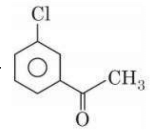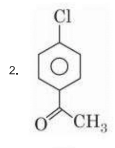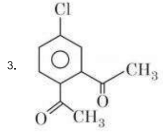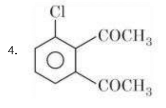The major product formed in the Friedel-Craft acylation of chlorobenzene is




To determine the major product formed in the Friedel-Crafts acylation of chlorobenzene, we can follow these steps:
Step 1: Understand the Reaction
Friedel-Crafts acylation involves the introduction of an acyl group into an aromatic ring. In this case, we are using chlorobenzene as the starting material and an acyl chloride (e.g., acetyl chloride, CH₃C(=O)Cl) in the presence of a Lewis acid catalyst (e.g., AlCl₃).
Step 2: Draw the Structure of Chlorobenzene
Chlorobenzene is a benzene ring with a chlorine atom attached. The structure can be represented as follows:
Cl∣C6H5
Step 3: Identify the Electrophile
In Friedel-Crafts acylation, the acyl chloride reacts with the Lewis acid to form an acylium ion, which acts as the electrophile. For acetyl chloride, the acylium ion is:
CH3C+=O
Step 4: Consider the Directing Effects
Chlorobenzene has a chlorine substituent, which is ortho-para directing due to its ability to donate electron density through resonance. This means that the acylium ion can add to the ortho or para positions relative to the chlorine atom.
Step 5: Draw Possible Products
The two possible products from the Friedel-Crafts acylation of chlorobenzene are:
1. Ortho product: Chlorobenzene with the acyl group at the ortho position.
2. Para product: Chlorobenzene with the acyl group at the para position.
Step 6: Analyze Steric Hindrance
While both ortho and para products can be formed, the ortho product will experience steric hindrance due to the proximity of the chlorine atom. This steric hindrance makes the ortho product less favorable compared to the para product.
Step 7: Identify the Major Product
Given the steric hindrance and the directing effects, the major product formed in the Friedel-Crafts acylation of chlorobenzene will be the para product.
Step 8: Write the Structure of the Major Product
The structure of the major product (para product) can be represented as follows:
Cl∣C6H4C(=O)CH3
Conclusion
The major product formed in the Friedel-Crafts acylation of chlorobenzene is the para-substituted product.
Friedel-Crafts acylation involves the introduction of an acyl group into an aromatic ring. In this case, we are using chlorobenzene as the starting material and an acyl chloride (e.g., acetyl chloride, CH₃C(=O)Cl) in the presence of a Lewis acid catalyst (e.g., AlCl₃).
Chlorobenzene is a benzene ring with a chlorine atom attached. The structure can be represented as follows:
Cl∣C6H5
In Friedel-Crafts acylation, the acyl chloride reacts with the Lewis acid to form an acylium ion, which acts as the electrophile. For acetyl chloride, the acylium ion is:
CH3C+=O
Chlorobenzene has a chlorine substituent, which is ortho-para directing due to its ability to donate electron density through resonance. This means that the acylium ion can add to the ortho or para positions relative to the chlorine atom.
The two possible products from the Friedel-Crafts acylation of chlorobenzene are:
1. Ortho product: Chlorobenzene with the acyl group at the ortho position.
2. Para product: Chlorobenzene with the acyl group at the para position.
While both ortho and para products can be formed, the ortho product will experience steric hindrance due to the proximity of the chlorine atom. This steric hindrance makes the ortho product less favorable compared to the para product.
Given the steric hindrance and the directing effects, the major product formed in the Friedel-Crafts acylation of chlorobenzene will be the para product.
The structure of the major product (para product) can be represented as follows:
Cl∣C6H4C(=O)CH3
The major product formed in the Friedel-Crafts acylation of chlorobenzene is the para-substituted product.
Topper's Solved these Questions
Similar Questions
Knowledge Check
Friedel Craft acetylation of chlorobenezene gives
A3-chloroacetophenoneB2-chloroacetophenoneC1-(4-chlorophyenyl) ethanoneD1-(3-chlorophenyl) ethanalFriedel-Crafts acylation is-
Aα-acylation of a carbonyl compoundBacylation of phenols to generate estersCacylation of aliphatic olefinsDacylation of aromatic nucleusWhich of the following would not given 2 - phenylbutane as the major product in a Friedel - Crafts alkylation reaction with benzene?
A1 - butene + HFB2 - butanol +H2SO4CButanoylchloride +AlCl3 then Zn−Hg/HClDButyl chloride +AlCl3

